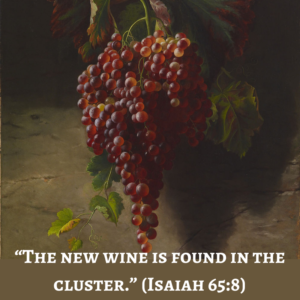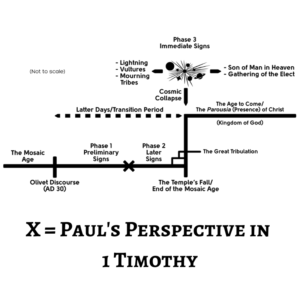
Paul believed a significant prophetic event would happen in his near future, perhaps during his lifetime, and he based that belief on the words of Christ. Inmillennialism,1 a prophetic view based on the Olivet Discourse and 1 Corinthians 15, accounts for this perspective.
As I have said (here), the Apostle’s closing paragraph in 1 Timothy reveals his underlying prophetic assumptions. The Lord’s appearance forms the central part of his charge to his young friend: “But you, O man of God … pursue righteousness … until our Lord Jesus Christ’s appearing” (1 Tim 6:11, 14).
A cluster of juicy prophetic grapes surrounds this stem. I glanced at three of them in my previous post (here). Now, I will examine two more.2
Changing Ages
Prophetic grape #4: God ending the Mosaic age and establishing the messianic age.
Paul reveals his two-age prophetic framework in this section. He tells Timothy to “command those who are rich in this present age not to be haughty.…” (1 Tim 6:17). A. T. Robertson, a renowned Greek scholar, says the Apostle means “‘in the now age’ in contrast with the future.”3
Paul does not leave us guessing about that future age; he says those who do good works “will lay up treasure for themselves as a firm foundation for the coming age (Gk. eis to mellon) so that they may take hold of the life that is truly life” (1 Tim 6:19 NIV).
The translators supplied the word age; it is not in the Greek. A literal translation would say Paul’s readers should prepare for the “about to be.”4 Paul uses the word mellō, and most translations ignore it in prophetic contexts. I’ve written here about why this is so.
The New Testament writers usually add a descriptive word when they use mellō. For example, in Luke’s account of Paul’s arrest in Jerusalem, he says, “Those who were about to (Gk. mellō) examine him withdrew from him” (Acts 22:29). The word examine shows what was about to happen.
When the writers omit a descriptive word, we must supply one based on the context. I will give an example from one of Jesus’ parables in which He used the exact phrase Paul uses in 1 Timothy 6:19:
A man had a fig tree planted in his vineyard, and he came seeking fruit on it and found none. And he said to the vinedresser, “Look, for three years now I have come seeking fruit on this fig tree, and I find none. Cut it down. Why should it use up the ground?” And he answered him, “Sir, let it alone this year also, until I dig around it and put on manure. Then if it should bear fruit next year (Gk. eis to mellon), well and good; but if not, you can cut it down.” (Luke 13:6–9 ESV)
The translators supply the words next year because the context shows the agricultural cycle was the thing “about to be.” Mellō gives the timing—soon; context provides the explanation—next year.
John Gill says this parable is “setting forth the patience of God towards the Jewish nation, their unfruitfulness, and the danger of their being destroyed, in case of non-amendment.”5 The parable’s “next year” meant God’s judgment of apostate Israel would happen soon; it was “about to be.”
In 1 Timothy 6:19, Paul has the same “about to be” perspective as Jesus. He envisioned an event in his near future that would divide “this present age” from the “about to be” age, the Mosaic age from the messianic age. This perspective fits the inmillennial prophetic model.
Paul’s language of nearness matches that of his Lord. God’s judgment of Israel, the temple’s fall, the end of the Mosaic age, and the complete inauguration of the messianic age were “about to be.”
From Paul’s perspective, those who had prospered in this present (Mosaic) age should not be haughty but lay a good foundation for the coming (messianic) age. The end of the old age and the start of the new era were “about to be.”
Giving All Things Richly to Enjoy
Prophetic grape #5: God giving us all things to enjoy in the messianic age.
Paul also hints at his prophetic perspective when he says, “God, who gives us richly all things to enjoy” (1 Tim 6:17). The present tense of the verb is important. Here is a literal translation: “The living God … is giving to us all things richly for enjoyment” (1 Tim 6:17 YLT).
Paul saw this as a process underway in his generation. God was moving His people from the Mosaic-age kingdom to the messianic-age kingdom. Jesus had said, “The kingdom of God will be taken from you [apostate Jews] and given to a nation [of true Jews] bearing the fruits of it” (Matt 21:43). The temple’s fall in His generation would complete that transfer (Matt 24:1–3, 34). This situation molded Paul’s prophetic outlook.
For the Apostle to say God was giving enjoyable things matches Jesus’ view of His ministry: “I have come that they may have life, and that they may have it more abundantly” (John 10:10). This abundant life would be a leading characteristic of the messianic age.
When Paul wrote, God’s people were transitioning from the Mosaic age to the messianic age; He was giving them all things to enjoy. We now have the “more abundant” life and the rich things of the kingdom.
Conclusion
A pastoral letter is not an obvious place to look for prophetic “new wine … in the cluster” (Isa 65:8). Yet, Paul concludes his first letter to Timothy with statements that show his prophetic framework. He saw the soon-coming appearance of Christ as the central stem. Around it, he placed five luscious grapes that produce a fine messianic-age wine: (1) God was giving life to all things, (2) manifesting Christ in His time, (3) defining true riches, (4) changing the ages, and (5) giving us all things richly to enjoy (1 Tim 6:11–19).
Paul understood his historical moment in terms of a framework similar to inmillennialism, as seen in the following diagram:

Footnotes
- For a full-length account of this prophetic model, see Michael A. Rogers, Inmillennialism: Redefining the Last Days (Tullahoma, TN: McGahan Publishing House, 2020). It is available here. For a summary, see the free PDF here.
- The image in this post is Bunch of Grapes by Andrew John Henry Way (1826–1888). This file (here) is in the public domain (PD-US) and was released under the Creative Commons Attribution-Share Alike 3.0 Unported License and the GNU Free Documentation License.
- A.T. Robertson, Word Pictures in the New Testament (Nashville: Broadman, 1933), 1 Ti 6:17.
- Paul R. McReynolds, Word Study Greek-English New Testament, 3rd ed. (Carol Stream, IL: Tyndale House, 1999), 1 Tim 1:19.
- John Gill, An Exposition of the Old and New Testaments, 9 vols. (1809–10; repr., Paris, AR: The Baptist Standard Bearer, 1989), 7:622.
